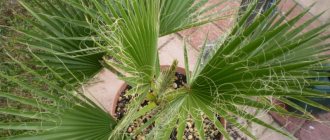Beautiful flowers, lush foliage on a thin leg - all this is indoor feces. It resembles a bouquet. Every person who has ever been given flowers will love this plant, because it evokes pleasant associations, touching memories. But sometimes the appearance begins to change, moreover, not for the better. What to do if calla lilies wither and turn yellow leaves? Let's figure it out.
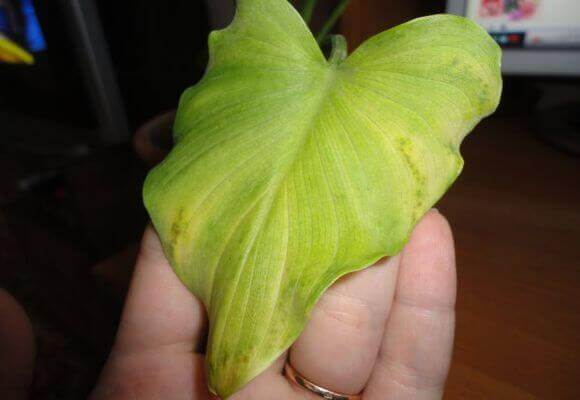
Why do calla lilies turn yellow leaves?
Calla lilies can turn yellow leaves for various reasons. Experts will help to find out why calla lilies start to hurt and how to cure them.
Calla lilies were recently purchased. Their leaves turn yellow and rot from the base
... Reason: waterlogging of the soil. Possible cause: high soil moisture level and low temperature in the room where the flower grows. Regardless of the type of calla (tuberous or rhizome), it does not like waterlogging of the soil. The situation can be aggravated by the low temperature of the plant.
Ways to fix the problem. If the calla leaves turn yellow and rot from the base, it is necessary first of all to normalize watering. You need to water the flower after the top layer of the soil dries. Next, watch the calla lily. If the leaves continue to turn yellow and rot, it is necessary to remove the flower from the pot along with the root system. Remove rotten parts of the tuber or root system. Sprinkle the cut points with crushed activated carbon. Rotten leaves cannot be removed. They should turn yellow naturally.
Next, the plant is either planted in the ground or sent to rest. If leaf rotting and their yellowing occurs in September - November, then the vegetation from the calla is cut off, and the tubers themselves are placed in a plastic bag on the lower tier in the refrigerator. You can get them in 2-3 months. If the leaves of the calla lilies do not turn yellow during the dormant period, then the rotten areas are cut off from the tuber of the flower and its root system, and the plant itself is transplanted into a smaller pot. The soil is used as follows: a mixture of perlite and peat 1: 1. Be sure to normalize watering. Calla lilies should remain in this soil until new leaves are expelled.
Calla leaves are covered with mucus at the base. At the same time, they became watery and lost their elasticity.
Reason: waterlogging. Ways to solve the problem. It is necessary to reduce watering. Calla lilies are watered only after the top layer of the soil has dried. Next, you need to remove the soil from the place at the base of the calla leaves, where rot is present. If the plant is bulbous, then the root crop may also be damaged. All rot from leaves and tuber must be removed with a sharp knife. Sprinkle the cut sites with crushed activated carbon. Places of rot should also not be covered with soil. It will not hurt to add Kornevin to the water for irrigation.
If calla lilies turn yellow leaves, what to do?
Calla lilies may turn yellow leaves from:
Waterlogging of the soil. In this case, it is necessary to normalize watering and check the tuber or roots for rot. If there are such areas, they are removed with a sharp knife. A plant with a large or medium sized tuber is transplanted into perlite. In this case, the root crop is sprinkled in half. If the calla lilies have not grown a tuber and their leaves turn yellow, then the plant can no longer be saved.
Rest period. Between September and November, indoor calla lilies retire. Their leaves turn yellow. Do not trim the leaves until they are completely dry.As soon as the last leaf has dried, the calla is removed from the pot and transferred to a dark, cold place for 2-3 months.
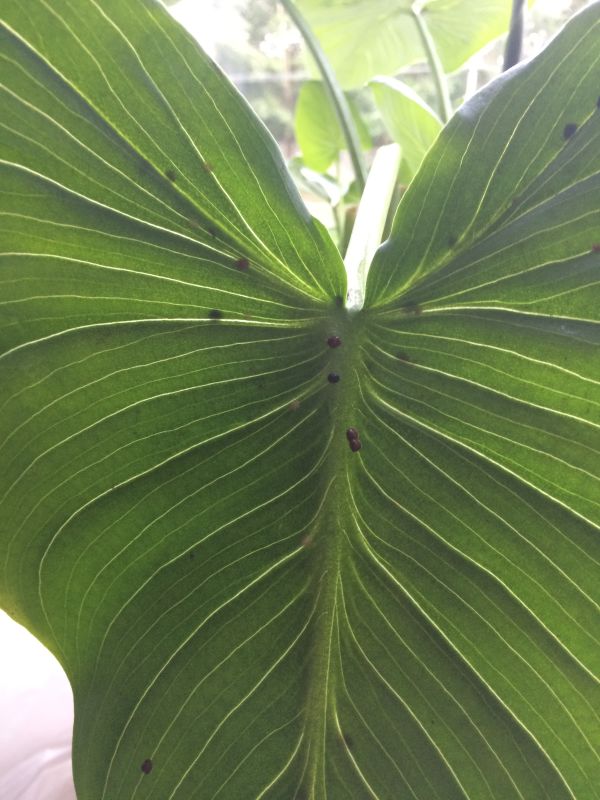

The calla flower leaf is covered with black or light brown dots that look like beads of wax. The latter can be easily removed with a fingernail without damaging the sheet plate. Reason: a scabbard or false shield has settled on the calla. Treatment of the disease: the plant is treated with actara, according to the instructions. This is a multiple treatment (3-4 times) with an interval of 7-10 days. The higher the temperature of the flower content, the more often the processing is carried out. For prophylaxis, all flowers standing next to the infected calla should be treated.
At home calla lilies the leaves turn yellow if a transplant was carried out with a complete replacement of the soil
... How is it - a complete soil replacement? This is when the plant is taken out of the pot, the soil is completely shaken off from the roots and transferred to new soil. Such a transplant is a great stress for the flower. A natural reaction is yellowing of the leaves. An adult calla should be transplanted by careful transshipment (without violating the integrity of the earthen coma) once every 2-3 years in a pot that is 1-2 cm larger than the previous one in diameter. Only the top layer of soil is replaced with fresh soil.
The exceptions are cases when the root system or flower bulb suffered from waterlogging and rot. Then calla lilies are transplanted with a complete replacement of the soil, significantly reducing the volume of the pot.
If the calla is transplanted with a complete replacement of the soil and its leaves begin to turn yellow, it needs special care until the moment of restoration. Watering is significantly reduced. Watering is carried out after the top layer of the soil has dried. More attention is paid to spraying. This is done 1-2 times a day, depending on the temperature of the flower's content. The higher the temperature, the more often it is sprayed. You can put a flower in a greenhouse. Calla is covered with transparent film, placed in a bright place, but not in direct sunlight. In the greenhouse, the plant is sprayed less often. High humidity for calla lilies during the recovery period is very important, since a weakened flower can infect a spider mite.


Calla lilies die, the leaf of the flower is covered with a sticky, white substance, which is powdered on top with a mealy bloom. Calla lilies dry and turn yellow leaves. Reason: a mealybug settled on the plant. Treatment of the disease: wash all the leaves with a cotton pad with a soap-oil emulsion. You can buy it at any flower shop. This is followed by treatment with aktara insecticide. Calla leaves are sprayed with a solution of the drug 4 g of the substance per 5 liters of water and the soil is spilled with a solution of the drug 1 g per 10 liters of water. The treatment is carried out 4 times with an interval of 7-10 days. The higher the temperature of the plant, the more often the treatment is carried out. Plants that are located next to the affected calla are subject to processing.
Care rules
Taking proper care of your calla lilies is not a difficult task. True, sometimes business distracts, it is difficult to remember the features of each flower and a mistake is made, moreover, constantly. It will be easier to understand why the leaves of room calla lilies turn yellow, if you remember the rules for its cultivation.
Caring is:
- soil selection;
- top dressing;
- watering;
- lighting;
- air temperature;
- irrigation of leaves;
- transfer;
- elimination of unnecessary parts.
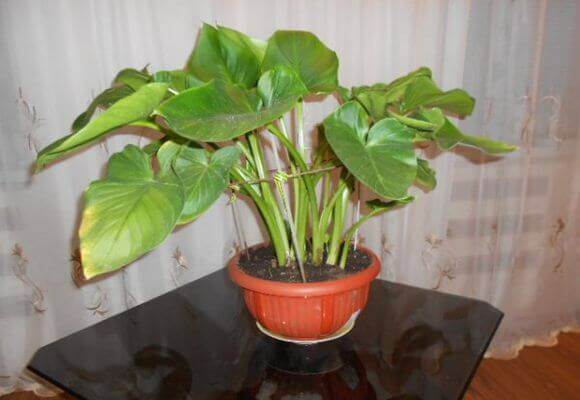

The source of nutrients is soil
In the process of life, the plant consumes minerals, salts and other nutrients from the environment, that is, from the pot. Improperly selected soil can lead to the death of the plant. Yellowing of the leaves is the first symptom.
Callas need a sod earthy mixture, with humus, peat. If a different one was chosen, it must be replaced and the plant will recover, it will feel comfortable in the future.
Important! The soil must be changed every 5–6 years, since the supply of nutrients in it is depleted.
Watering rules and subtleties
Often the reason why calla lilies turn yellow leaves is insufficient watering. The plant loves water and it is desirable that the soil is always moist. In February, on the eve of spring, place the pot in a pots with slightly warm water and maintain its level, add as it evaporates. Humid air is one of the advantages of the method.
However, the risk of excessive moisture should not be forgotten. If the soil is too wet, the cuttings may start to rot. A sure sign is a sour smell coming from the soil.
Watering should be reduced for a while. It so happens that you simply need to remove the plant from the pot, dry it for several days, then transplant. At best, a sad page in the book of life will be turned over, the mistake will be corrected. At worst, you have to treat the flower.
Important! In autumn and winter, the growth of calla lilies slows down, a dormant period begins and watering should be reduced.
Watering calla, it is not enough to follow the recommendations, you need to carefully consider the state of the plant. A timely response to the changing needs of the flower is the key to success in care.
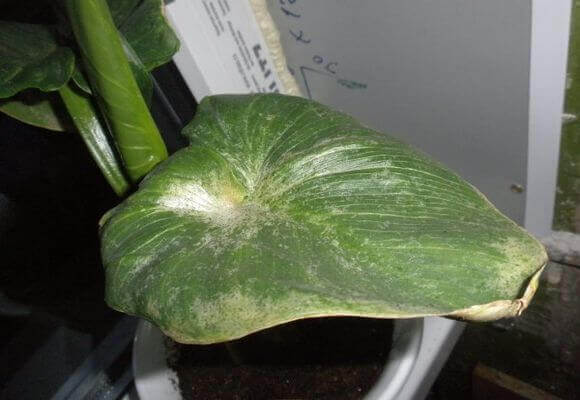

Fertilizer
If you choose a good soil for planting, top dressing will not be needed at first. But calla lilies have constantly changing leaves, they often bloom and grow quickly. Alas, literally in a year or two the general condition, the appearance may deteriorate noticeably.
Due to the lack of nutrients, the leaves can turn yellow massively, the leaves dry up, the flowers fall off, never blooming, not appearing at all, new parts become smaller. These are alarming signals. From now on, caring for a home plant should include feeding.
Suitable:
- Mineral fertilizers.
- Organic elements.
- New soil.
Fertilizers are sold in any specialized store, applied in accordance with the instructions. Organic matter is compost, all that humus gives.
They are placed near the walls of the pot, having previously made depressions, then covered with a layer of earth. You can also replace the topsoil in the pot periodically. This will avoid the appearance of yellow leaves that spoil aesthetics and harmony.
Lighting and air temperature
Drafts often cause calla lilies to have a lot of yellow leaves all the time. The optimum air temperature for it is from +20 to +24. In winter, the temperature is needed in the range from +13 to +16. The flower is sensitive to heat and frost and should be avoided.
Improper lighting sometimes results in yellow foliage. She does not like extremes, prefers moderation, medium-intensity lighting.
Important! Provide the plant with regular, short-term direct sunlight. Only in this case the foliage will always be green.
Root damage
Often, if yellow leaves appear, you should expect the situation to worsen, since negative processes will soon affect or have already affected the root system. If foliage is not removed in a timely manner, it can cause problems with other parts of the calla lily.


It also happens that it is the roots that provoke the wilting of the aboveground part. There is only one way to check their condition - to remove the flower from the soil. Rotten ones must be removed.
Why does calla not bloom?
Why not calla lilies at home. In most cases, potted calla lilies do not bloom due to improper care. So, let's take a closer look at why the beloved flower does not want to expel the flowering arrow.
Domestic calla does not bloom if during the previous growing season it did not receive enough fertilizing, the watering regime of the plant was violated, and the level of illumination was insufficient. For calla lilies to bloom, they need proper care.
Calla lilies do not bloom in pots. if the plant did not have a dormant period or it did not last long. The resting period for calla lilies lasts from September-November to February-March. During this time, the plant gains strength. Calla needs to be watered occasionally.Otherwise, the root system will completely dry out. You can not forcibly send the plant to rest and cut off the green leaves. Calla leaves should dry out on their own.
Calla does not bloom at home if there are many baby tubers around the mother tuber. The latter take away strength from an adult plant. In this case, it is necessary to carry out a flower transplant with the separation of children. This is done after the end of the dormant period of calla lilies. It is necessary to provide her with proper care and the calla lilies will bloom next year.
Calla will not flower if it has suffered an illness during the previous growing season. To correct the situation, the plant is provided with normal care.
To the question Why do the leaves of feces turn yellow, given by the author European
the best answer is. She began a period of rest. Remove all leaves and place in a dark and cool place for 3 months without watering. Then take it out, transplant it into a slightly large pot, put it on the window and start watering.
Answer from 22 answers
[guru]
Hey! Here is a selection of topics with answers to your question: Why do kala leaves turn yellow
Answer from Irina Zolotareva
[guru] If the bottom, then this is normal, they periodically die off, if the rest, then perhaps from a lack of moisture or a violation of the temperature regime.
Answer from Natalie Filini
[guru] Analyze your care for this plant: Calla prefers shady and semi-shady places, where, if there is sun, it is only in the evening. For growing calla lilies, a spacious container is used: high (above 60 cm) and wide (within a radius of 15-20 cm from the point of plant growth). The substrate is made up of ordinary garden soil. A little clay, a little vermiculite, as well as sand, rotted manure and peat are added to it. Mineral fertilizers are applied to the resulting substrate and everything is thoroughly mixed. The nutrients contained in the substrate are enough only for the first year of the calla's life. In the future, growing, the plant requires the enrichment of the substrate: replenishment of the stock of organic fertilizers and minerals. The shoots of the growing calla lilies will not become smaller if they are fed with organic matter in a timely manner. To do this, along the edge of the heavy and voluminous calla lily pot, they carefully dig a groove and add any organic matter in the house. You can use, for example, peel from fruits (bananas, kiwi apples, etc.), seed husks, tea leaves, etc. The introduced organic matter is sprinkled with a substrate, the plant is spilled with water at room temperature. In the future, calla lilies fed with organic matter are watered with mineral fertilizer dissolved in water (according to the instructions on the package). Periodically, the topsoil in the calla lily pot can be replaced (with care so as not to damage the rhizome) with a more nutritious substrate. Then the plant will successfully grow in a pot for quite a long time without transplanting. Calla is very moisture-loving, so the substrate must be kept moist and never dry out. It is also a prerequisite for the development of beneficial soil bacteria, which convert organic matter into fertilizer available to plants. Also, calla is not afraid of the presence of earthworms in the pot, this is even welcome. Due to the presence of earthworms in the substrate, the processing of the introduced organic matter into humus is accelerated. And worms also carry out loosening and enrichment of the soil with oxygen. When a peduncle appears in a calla, you can slightly (so as not to burn the roots of the plant) increase the dose of nitrogen-potassium fertilizer. They prefer to use urea, which improves the acidity of the soil, which is beneficial for calla lilies. When the calla inflorescence is at the beginning of dissolution, calcium is added to the substrate (for example, an egg shell infusion is suitable). Then the half-open flower stalk of the calla when cut (or if the plant blooms in a pot) retains its freshness longer and does not fade as quickly as it happens in nature.Calla pleases with its pristine fresh snow-white flower for more than a week.
Answer from Vote
[guru] The leaves of the plant are often and regularly renewed - new ones grow, and the old ones quickly turn yellow and die off, they must be removed, this is a natural phenomenon for calla lilies. If everything turns yellow, then it is either overdrying or overflowing the substrate. Or maybe the plant is preparing for a dormant period.
Answer from luxury
[guru] In general, calla lilies can have a dormant period, so I think this is normal ..
Answer from Kakbe Kote ... and All All All
[guru] Because you don't use them !!!
Answer from AliNo4ka
[guru] My feces also had yellow leaves. Now she "sleeps" in my refrigerator, I hope she will wake up.
Every year, after a dormant period Summer 18-22, during a dormant period 10-15 During a period of active growth and flowering - daily, during a dormant period - once every 10 days During a flowering period - 2 times a day Diffused lighting, partial shade For flowering, a period is required rest
Pests and diseases
Calla lilies leaves turn yellow and wither, in addition to improper watering, lighting, air temperature, feeding, can also be due to diseases and pests.
Spider mite
There are pests who like the structural features of the plant. For example, a spider mite. Calla, which is popularly called calla because of its white flowers, will be completely occupied, covered with a white spider web, if this parasite has settled on it.
The tick likes coolness and shade. Calla stems are an ideal habitat. To get rid of it, you need to arm yourself with laundry soap. You should carefully wash the plant, protecting the ground from drops, splashes, rinse after that with plain water, repeat the procedure until the population is completely destroyed.
Other parasites on the flower
Aphids, scale insects are possible reasons why the leaves turn yellow and the plant withers. The sooner help is provided, the better, but these pests can be difficult to detect.
Important! A sure sign of the presence of pests is leaf curling and small spots that give a yellow tint.
The plant is treated with special preparations, which are often needed, are always on sale. It is advisable, in addition, to sprinkle the surface of the soil in the pot with hot ground pepper. A simple trick will lead to serious disruptions to the life cycle of the pest, and will allow it to be destroyed faster.
There can be many reasons for the appearance of yellow leaves in calla lilies. The main task when faced with this problem is to carefully examine the plant, not to lose sight of the details, important trifles. The situation will quickly become clear if you take what is happening responsibly. The solution will be found, the flower will be saved.
Lighting
Calla is a light-loving plant, but the lighting for its growth and flowering must be diffused. Does not tolerate direct sunlight.
The flower can be grown in partial shade
, he can even endure a shadow, but such lighting negatively affects his flowering.
Poor lighting can be the reason why calla lilies do not bloom or bloom very poorly.
On hot summer days, it is especially important to protect the flower from the scorching rays of the sun. To do this, the pot can be rearranged on a floor stand and / or covered with a translucent curtain.
Calla needs good lighting all year round.
She prefers a long daylight hours, so in autumn and winter it is recommended to supplement the plant with artificial fluorescent or phytolamps.
The main reasons
Perhaps the reason that the color of the leaves has changed, a yellow tint, spots have appeared, is in improper care. The flower can get sick. Both options need to be considered. Only the right conclusions, timely, relevant measures will help restore harmony on the windowsill.
Important! Each calla leaf lives on average for six months, turns yellow, dries up, falls off, and a new one grows in its place.The natural life cycle must be distinguished from disease.
Temperature
It is a plant with a pronounced dormant period that lasts 2 months a year and begins after flowering ends. From the beginning of the growing season, a stable temperature with small average daily differences is needed.
It is best to keep the flower in a room at a temperature of 18-22 ° C.
... This plant does not like heat; at temperatures above 27 ° C, its leaves begin to dry out, despite the humidification of the air. The cold is also detrimental to him, although the Ethiopian calla can withstand a short-term temperature drop of up to 5 ° C.
During the dormant period, the temperature of the plant should be between 10-15 ° C.
Leaf yellowing as a natural process


If the lower leaves begin to change color, there is no cause for concern. Thus, the calla is simply renewed.
Each leaf lives no more than 6 months, then it gradually dies off, making room for new ones.
The same applies to the yellowing of the leaves in the autumn - then the life processes of the flower freeze, and he himself begins to prepare for the dormant period, throwing off the leaves.
In this case, you should wait until all the leaves are dry (without forcibly cutting them off), and then place the plant in a cool dark room until spring.
Watering
It is a marsh plant for which abundant watering is vital. When growing it in pots, a lump of earth in and flowering should never dry out. You need to water it daily, but it is better from the bottom through the pallet. When watering from above, care must be taken so that water does not fall on top of the tuber or growing point.
During the rest period, watered about 1 time every 10 days.
... The soil should be slightly damp at this time. For watering the plant, only warm, settled soft water is used.
Calla lilies stop growing due to insufficient soil moisture.
15 minutes after watering, all the water that has flowed into the sump is drained. This will prevent decay of the root system.
After flowering, the regularity of watering for all species is reduced to 1 time in 7-10 days. After 1-2 months, watering of colored calla lilies must be stopped until the end of the dormant period (end of February).
Calla home care
Natural leaf death occurs in the fall, when the calla is preparing for the recovery period. At this time, you need to reduce watering, fertilizing and transfer the pot with the plant to a cool, dark place until spring.
Another reason for this phenomenon is improper care. Calla prefers high humidity. To make the plant feel good, you need to often spray it with water at room temperature from a spray bottle.
Too bright light and direct sunlight can also cause yellowing and wilting of leaves. With improper watering, when the root system is waterlogged or overdried, the calla leaves also change color and wither.
Watering with cold water can cause not only yellowing of the leaves, but also the death of the root system, which can lead to the death of the calla. The same will happen if the plant is systematically flooded with water. To avoid this, you need to plant the calla in a pot with drainage holes.
Another reason is the lack of nutrients in the soil, which occurs with improper fertilization and depletion of the soil during long-term cultivation of calla lilies in one container. To avoid this, it is necessary during the growing season to feed with full mineral fertilizer for flowers once every two weeks.
Calla lilies are quite unpretentious and do not require special care when grown at home and in the garden. However, in order for the cultivation of these delicate flowers to become carefree for you, you need to follow certain rules for planting and caring for calla lilies.
It is worth paying special attention to the fact that when growing calla lilies there is a risk of damage to the flower by diseases and pests.Preventive measures and methods for treating a flower and getting rid of parasites are described in this article in a separate paragraph, so that you do not have any difficulties with this.
The article also provides instructions for choosing a variety, planting and caring for, transplanting and propagating calla flowers, observing which you will decorate your gardens with wonderfully flowering plants, which will not require a lot of time and attention.
Calla (Cálla –lat.) Belongs to the genus of perennial coastal and wetland plants. Translated from Greek, the name "calla" means "beautiful". The habitat is swampy shores and swamps of the Northern and Southern Hemispheres.
It is found in regions with subtropical, temperate and subarctic climates. This plant can be seen in its natural environment in Russia, Europe, Canada and South Africa.
- In various literary sources "calla lilies" are called similar species from the Aroid family. Among them: calla, arum, zandexia.
- Until recently, only Zantedexia from Ethiopia (Zantedeschia aethiopica - lat.) Was grown in Russia - a tall plant with thin yellow-cob inflorescences wrapped in snow-white bracts-bedspreads.
- Today, in addition to whites, florists have at their disposal such varieties as: golden-yellow Calla Elliott, pink-lilac and red-burgundy Calla Remman.
- The conditions for growing plants with multi-colored bracts are often fundamentally different from the usual agrotechnical methods of caring for white calla lilies.
The flower has a thick hollow rhizome that spreads over the soil surface. In species with white bracts, the root system does not have bulbs or tubers. Calla lilies with colorful veils are tuberous plants.
Calla lilies have single, oval-heart-shaped leaves. They have a shiny thick plate, the length of which reaches from 6 to 14 cm, and the width is from 5 to 12 cm. The top of the leaf plate is pointed, resembling arrowheads.
Small, unisexual flowers, which form tall cobs, are arranged on a thick, upright stem. The flowers are surrounded by a spectacular veil - a large funnel-shaped bracts, which in nature have a white inner color.
The fruits are bright red berries that form a cylinder-shaped ear. Ripen thirty days after the end of flowering. Under natural conditions, ripening occurs in late summer or early autumn.
Calla is one of the most popular plants among landscape designers, florists and florists. It is not surprising that breeders have bred its numerous varieties, which are successfully used for composing romantic bouquets, and for decorating personal plots, and for placement in interiors.
In order for a calla to have a gorgeous appearance, you must follow a couple of rules:
- Domestic calla lilies are not whimsical, it is a pleasure to take care of them. To make her comfortable, she needs light, warmth and a small pot - this will be enough for her to grow and delight with her flowering.
- Indoor feces need a sufficient amount of water. It is very important that moisture is maintained during the growing season. When the flower reaches maturity, you need to water it sparingly, only after the top layer has dried can you water it. It is best to water when the soil is completely dry. If the water stagnates a little in the pot, then this will provoke decay, drying of the roots is irreversible.
- At home, this plant needs to be fed from January to March. Fertilize it once a week. You can buy a special fertilizer, and if you don’t find it, you can safely purchase fertilizer to stimulate flowering.
- One of the most important points is the indoor air. If the temperature is above 20 ° C, the plant should be sprayed daily with a spray bottle.
- After purchase, the flower should be transplanted into a larger pot.She loves slightly acidic earth. Mix a little sand, deciduous soil and peat. Transplant once a year in November.
- Maintain a temperature of 23 ° C in summer, 14 ° C is normal in winter. The flower should never stand in a draft. In the spring, accustom the flower to the light gradually. Cut off yellowed or withered leaves.
- This plant can have the following diseases: anthracnose, gray rot, bacterial or root rot. All these diseases manifest themselves only if you have not been properly looked after. Avoid direct sunlight, drafts, drying out or waterlogging of the soil, and then your feces will be healthy.
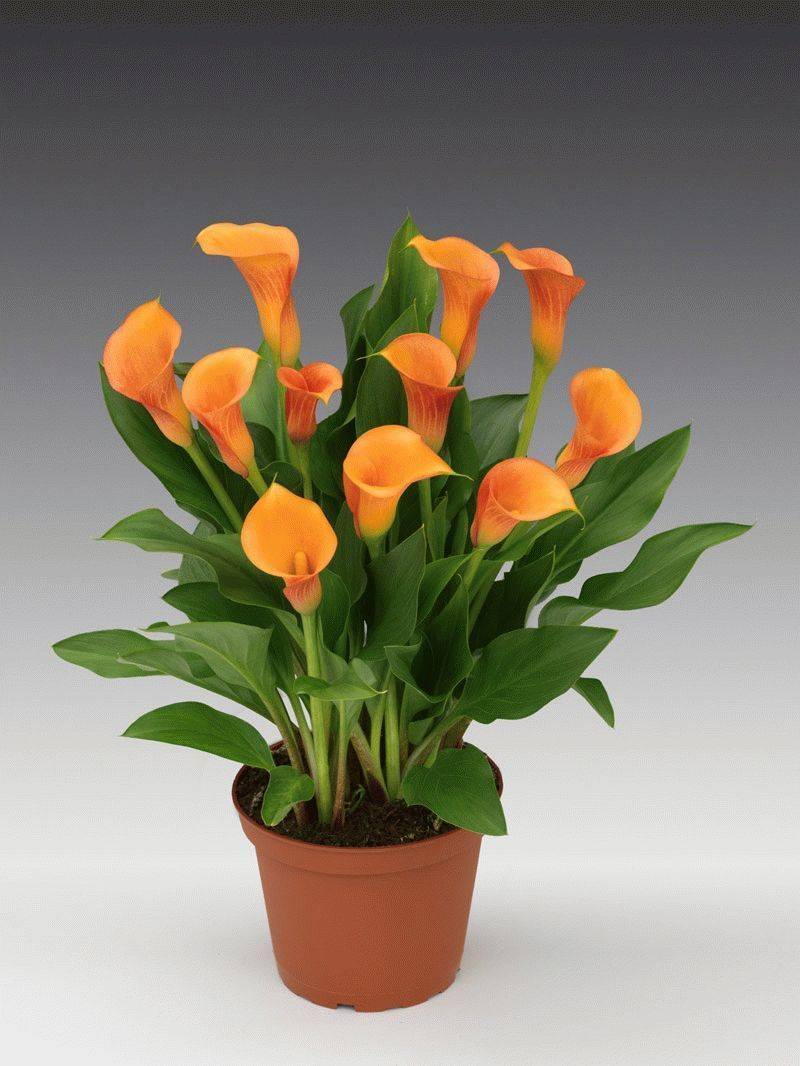

If you decide to have such a "miracle" for yourself, then you should prepare for its appearance:
- For cultivation, a window sill is ideal, which is illuminated only at the end of the day.
- Pick up the pot. The correct choice would be a pot with a height of at least 60 centimeters, and the radius from the point of growth of the flower should not be less than 20 centimeters. The fact is that growth occurs quite rapidly if properly fed. This can be done not only with ready-made fertilizers. You can dig a small groove around the edge of a large pot, then add some fruit peels, seed husks, and soil over it. Drizzle with water at room temperature, and add tea leaves periodically.
- Periodically, it is necessary to remove the top layer and change it to a nutritious substrate. Do this carefully so as not to damage the roots. In this way, you can achieve long-term growth without transplantation.
Remember that white and colored calla lilies need a different approach. Whites need more moisture. During the dormant period, they do not shed their leaves, but their growth continues. Colored, in turn, are not so demanding on moisture.
Lovers who grow plants at home consider indoor calla lilies to be the most beautiful indoor flower. It is difficult to disagree with them, a huge single-leaved flower with a bright cob attracts attention, and the flower itself pleases for a whole month.
Calla lilies are native to southern Africa, but the modern range of this plant has spread far beyond the continent.
Relatively recently, it was possible to find such a flower in our latitudes only on a swampy area, but thanks to the work of botanists, growing calla lilies at home is quite a common event today.
The home plant calla appears in people's homes, not only for its appearance. This flower is an accurate barometer; drops form on the leaves just before the rain. Let's take a closer look at how to care for home calla lilies.
Popular types
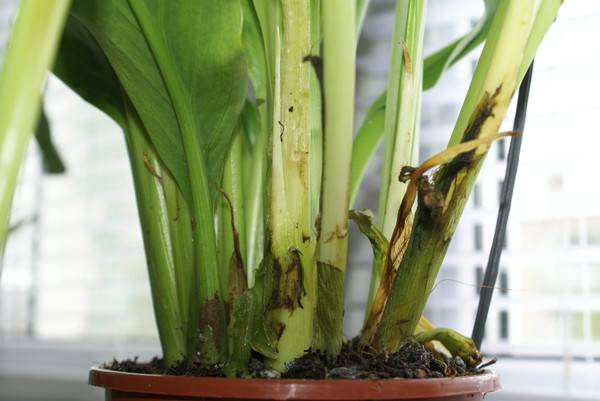

Thanks to the hard work of botanists in breeding this plant, today we are able to cultivate a large number of different types of domestic calla lilies.
Calla elliottiana (Calla elliottiana) is an abundantly flowering flower variety that is distinguished by a special love for illuminated places and regular watering. The flower is painted in very contrasting colors: the outer part is yellow-green, and the inner part is bright yellow.
Ethiopian calla (Calla aethiopica) - this variety is rightfully ranked first in popularity. Calla flowers are white with a yellow core, the only leaf of the flower is curled up and has an extension towards the top. The dense leaves of this species can be up to 45 centimeters in length, and the stem grows up to 1 meter.
We invite you to familiarize yourself with: Red Scarlet: characteristics, description and cultivation of potatoes
Remanna (Calla rehmannii) is a miniature variety (up to 50 cm in height), distinguished by a bright flower color from pink to deep red. The flowers of red calla lilies served as a starting point for breeding varieties with a variegated color.
Amethyst is the choice of sophisticated people. Delicate shades of inflorescences intertwine with the aromas of the sea air, creating an atmosphere of comfort and luxury. This flower variety has become an integral part of women of royal blood.
These are not all types of indoor calla lilies, thanks to selection, new varieties appear on the market every year. Bred indoor calla lilies are more and more variegated and sophisticated colors.


Plants of this culture differ in many respects from other indoor inhabitants, this establishes a certain imprint on the care of calla lilies. Taking care of calla lilies at home is not difficult, but you need to be careful about all the requirements.
Spraying
To maintain the air humidity necessary for the plant, it must be sprayed frequently. In summer, in hot weather, you can spray twice a day - in the early morning and after sunset.
Calla responds well to leaf moistening with a wet sponge or cloth
... During the dormant period, the plant is not sprayed, since it lives mainly due to the tuber, the humidity of the air does not affect it.
Calla lilies need a very fertile and acidified soil. In earth with an alkaline reaction, they will not grow.
Peat in the composition of the substrate for calla lilies must be present.
The best earthen mixture for growing them is the following: sod land, peat, humus and coarse sand in a ratio of 1: 1: 2: 1.
For white varieties, you can use a commercially available flowering aroid substrate. Another option is to prepare the soil mixture yourself, mixing one part of humus, sand and leafy earth, adding ¼ part of clay and 2 parts of sod land.
For all types of calla lilies, 1 tbsp is added to 3 liters of substrate. spoon of superphosphate.
This article is often read:
Subtleties of care
But most often, calla leaves begin to turn yellow as a result of improper care. So, the most common errors are:
- Wrong location. First of all, this applies to illumination. The southern window is not the best choice for calla lilies, since there they will be under the sun most of the day. It is better to give the flower an oriental window sill with moderate lighting. Do not forget about the temperature regime, because calla is highly sensitive to both high and low temperatures. In summer, it is advisable not to allow it to rise above 24 degrees Celsius; in winter, a cooler regime (from 13 to 16 degrees Celsius) should be maintained.
- Unsuitable pot. Leaves can disappear if the flower is planted in a pot that is too small and there is not enough space for it.
- Violation of the watering regime. Both dry and flooded soil are unacceptable for calla lilies. In addition, if the ground is constantly wet, the roots begin to suffer - they rot. Also, you can not water the flower with cold water.
- Malnutrition. In the case when calla is in the same soil for a long time without additional feeding, it begins to experience a lack of nutrients, which affects the development and general condition of the plant. It is important to regularly feed it with complex preparations in the spring-summer period (twice a month) and periodically change the soil.
There are several rules to remember when planting calla lilies on your windowsill.
The correct choice of soil is the key to the health of the entire plant. It is necessary to pick up a mixture of earth, peat and humus. If the mixture is not correct, then the plant may suffer.
Sometimes the leaves begin to turn yellow due to insufficient watering. It is necessary that the soil is always moist. At the end of winter, you can put the pot in a container with warm water to determine the proper level of moisture.
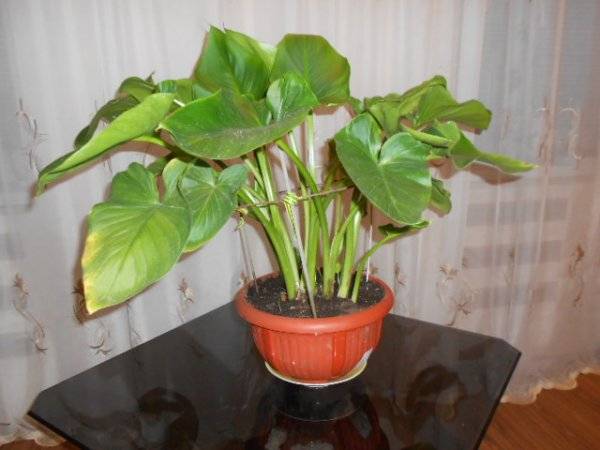

It will be necessary to temporarily reduce watering and dry the soil. If the lesion is too severe, then treatment of the flower may be required. But, when calla lilies fall into a dormant period, the amount of moisture must be reduced.
Another reason for yellowing can be considered a lack of fertilizer. Even if high-quality soil was used during planting, it is quickly depleted.Therefore, in order to maintain a healthy look of plants, it is necessary to regularly introduce mineral and organic substances, as well as to renew the soil in time.
Another reason for yellowing can be the incorrect temperature of the content. Calla lilies are equally sensitive to both a decrease in temperature and a decrease in temperature. In summer, you need to maintain a regime from 20 to 24 degrees, in winter - from 13 to 16.
If the yellowing has already begun, then this will negatively affect all parts of the plant. The roots can also be damaged. But this also happens the other way around. If the leaves begin to turn yellow, then you should examine the roots and remove the rotten particles.
There are also reasons for the appearance of yellowness on the leaves - diseases and pests. Pests most often appear in the form of yellowing and curling of foliage. This is a spider mite, aphid, scale insect or whitefly. Most often, special drugs will be required for treatment, which can be bought at any specialty store.
Taking proper care of your calla lilies is not a difficult task. True, sometimes business distracts, it is difficult to remember the features of each flower and a mistake is made, moreover, constantly. It will be easier to understand why the leaves of room calla lilies turn yellow, if you remember the rules for its cultivation.
Caring is:
- soil selection;
- top dressing;
- watering;
- lighting;
- air temperature;
- irrigation of leaves;
- transfer;
- elimination of unnecessary parts.
In the process of life, the plant consumes minerals, salts and other nutrients from the environment, that is, from the pot. Improperly selected soil can lead to the death of the plant. Yellowing of the leaves is the first symptom.
We offer you to familiarize yourself with: Azistasia planting and care growing from seeds
Callas need a sod earthy mixture, with humus, peat. If a different one was chosen, it must be replaced and the plant will recover, it will feel comfortable in the future.
Important! The soil must be changed every 5–6 years, since the supply of nutrients in it is depleted.
Often the reason why calla lilies turn yellow leaves is insufficient watering. The plant loves water and it is desirable that the soil is always moist. In February, on the eve of spring, place the pot in a pots with slightly warm water and maintain its level, add as it evaporates. Humid air is one of the advantages of the method.
However, the risk of excessive moisture should not be forgotten. If the soil is too wet, the cuttings may start to rot. A sure sign is a sour smell coming from the soil.
Reduce watering for a while. It so happens that you simply need to remove the plant from the pot, dry it for several days, then transplant. At best, a sad page in the book of life will be turned over, the mistake will be corrected. At worst, you have to treat the flower.
Important! In autumn and winter, the growth of calla lilies slows down, a dormant period begins and watering should be reduced.
Watering calla, it is not enough to follow the recommendations, you need to carefully consider the state of the plant. A timely response to the changing needs of the flower is the key to success in care.
Fertilizer
If you choose a good soil for planting, top dressing will not be needed at first. But calla lilies have constantly changing leaves, they often bloom and grow quickly. Alas, literally in a year or two the general condition, the appearance may deteriorate noticeably.
Due to the lack of nutrients, the leaves can turn yellow massively, the leaves dry up, the flowers fall off, never blooming, not appearing at all, new parts become smaller. These are alarming signals. From now on, caring for a home plant should include feeding.
Suitable:
- Mineral fertilizers.
- Organic elements.
- New soil.
Fertilizers are sold in any specialized store, applied in accordance with the instructions. Organic matter is compost, all that humus gives.
They are placed near the walls of the pot, having previously made depressions, then covered with a layer of earth.You can also replace the topsoil in the pot periodically. This will avoid the appearance of yellow leaves that spoil aesthetics and harmony.
Drafts often cause calla lilies to have a lot of yellow leaves all the time. The optimum air temperature for her is from 20 to 24. In winter, a temperature is needed in the range from 13 to 16. The flower is sensitive to heat and frost, they must be avoided.
Improper lighting sometimes results in yellow foliage. She does not like extremes, prefers moderation, medium-intensity lighting.
Important! Provide the plant with regular, short-term direct sunlight. Only in this case the foliage will always be green.
Root damage
Often, if yellow leaves appear, you should expect the situation to worsen, since negative processes will soon affect or have already affected the root system. If foliage is not removed in a timely manner, it can cause problems with other parts of the calla lily.
It also happens that it is the roots that provoke the wilting of the aboveground part. There is only one way to check their condition - to remove the flower from the soil. Rotten ones must be removed.
Every year, after a dormant period Summer 18-22, during a dormant period 10-15 During a period of active growth and flowering - daily, during a dormant period - once every 10 days During a flowering period - 2 times a day Diffused lighting, partial shade For flowering a period of rest is required
Calla is a light-loving plant, but the lighting for its growth and flowering must be diffused. Does not tolerate direct sunlight.


The flower can be grown in partial shade, it can even tolerate shade, but such lighting negatively affects its flowering.
Poor lighting can be the reason why calla lilies do not bloom or bloom very poorly.
On hot summer days, it is especially important to protect the flower from the scorching rays of the sun. To do this, the pot can be rearranged on a floor stand and / or covered with a translucent curtain.
Calla needs good lighting all year round. She prefers a long daylight hours, so in autumn and winter it is recommended to supplement the plant with artificial fluorescent or phytolamps.
Loading ...
Temperature
It is a plant with a pronounced dormant period that lasts 2 months a year and begins after flowering ends. From the beginning of the growing season, a stable temperature with small average daily differences is needed.
It is best to keep the flower in a room at a temperature of 18-22 ° C.
This plant does not like heat; at temperatures above 27 ° C, its leaves begin to dry out, despite the humidification of the air.
During the dormant period, the temperature of the plant should be between 10-15 ° C.
It is a marsh plant for which abundant watering is vital.
When growing in pots, the lump of earth during the growth and flowering period should never dry out. You need to water it daily, but it is better from the bottom through the pallet.
When watering from above, care must be taken so that water does not fall on top of the tuber or growing point.
During the rest period, watered about 1 time in 10 days. The soil should be slightly damp at this time. For watering the plant, only warm, settled soft water is used.
Calla lilies stop growing due to insufficient soil moisture.
15 minutes after watering, all the water that has flowed into the sump is drained. This will prevent decay of the root system.
After flowering, the regularity of watering for all species is reduced to 1 time in 7-10 days. After 1-2 months, watering of colored calla lilies must be stopped until the end of the dormant period (end of February).
Spraying
To maintain the air humidity necessary for the plant, it must be sprayed frequently. In summer, in hot weather, you can spray twice a day - in the early morning and after sunset.
Calla responds well to moisturizing the leaves with a wet sponge or cloth.
During the dormant period, the plant is not sprayed, since it lives mainly due to the tuber, the humidity of the air does not affect it.
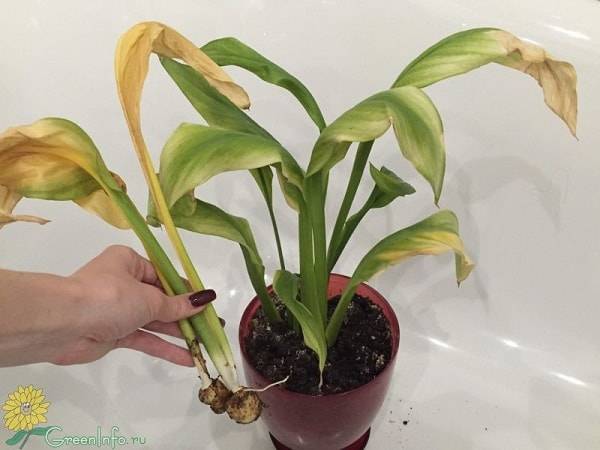

Calla lilies need very fertile and acidified soil. In earth with an alkaline reaction, they will not grow.
Popular types
Fertilizer
Plant feeding is carried out during growth and flowering. The plant reacts very well to feeding with superphosphate twice a month. You can also use complex fertilizers for flowering plants. During the dormant period, you should not feed the flower.
Calla lilies especially need feeding when there is a lack of lighting.
Nitrogen fertilizers should not be overused before flowering.
so that the intensive growth of green foliage does not drown out the formation of buds. After the appearance of flower stalks, calla can be fertilized with urea. During flowering, organic feeding with eggshell infusion is recommended.
It is useful to alternate root dressing with spraying on the leaf. In this case, it is important to ensure that drops do not fall on the flowers.
Calla - home care, growing in a pot and in the garden
Why not calla lilies at home. In most cases, potted calla lilies do not bloom due to improper care. So, let's take a closer look at why the beloved flower does not want to expel the flowering arrow.
Domestic calla does not bloom if during the previous growing season it did not receive enough fertilizing, the watering regime of the plant was violated, and the level of illumination was insufficient. For calla lilies to bloom, they need proper care.
Calla lilies do not bloom in pots. if the plant did not have a dormant period or it did not last long. The dormant period for calla lilies lasts from September-November to February-March. During this time, the plant gains strength. Calla needs to be watered occasionally. Otherwise, the root system will dry out completely. You can not forcibly send the plant to rest and cut off the green leaves. Calla leaves should dry out on their own.
Calla does not bloom at home if there are many baby tubers around the mother tuber. The latter take away strength from an adult plant. In this case, it is necessary to carry out a flower transplant with the separation of children. This is done after the end of the dormant period of calla lilies. It is necessary to provide her with proper care and the calla lilies will bloom next year.
Calla will not flower if it has had an illness during the previous growing season. To correct the situation, the plant is provided with normal care.
Popular types
Calla belongs to the Aroid or Aronnikov family. It is customary to read the homeland of calla lilies in South Africa, some species can be found in the central part of Africa, even in our latitudes you can find wild species of calla lilies that feel good in swampy areas.
A feature of calla lilies is that they can be grown both as a houseplant and as a garden plant. Other names for calla lilies include the following: calla lily and arum.


Calla is a relatively small plant with heart-shaped foliage (leaf length up to 12 centimeters, and width - 11 centimeters).
The flowers are formed on a long peduncle and is an ear that is wrapped in a funnel-shaped petal - a blanket.
Homemade calla lilies usually do not differ in aromas, but calla lilies grown in the garden exude an aroma reminiscent of a combination of pineapple and vanilla.
Features of the
Calla for long and abundant flowering should rest 2 months a year. The rest of the time falls on its growth and flowering. The dormant period for plants occurs at different times, especially when kept in an apartment.
To organize a dormant period for the plant, after the end of flowering, you need to water it less often, and then almost stop watering. The leaves of the plant turn yellow and dry up, it goes into a state of dormancy. Some flower growers do not stop watering and feeding after flowering. So it is possible to achieve a second flowering in the season, but after that a dormant period for the plant is already necessary.
Calla lilies usually have rest periods in July and August or January and February.
Their dry leaves are cut off, and the pot is removed to a colder and darker place. After the end of the rest, they are transplanted into a new land. Now it is important to wake up the plant correctly so that it begins to grow intensively and blooms soon.
Experienced growers recommend waiting for the plant to wake up on its own.
, and immediately after transplanting it is good to pour it with acidified lemon juice water. For 0.5 liters of warm water, you need a few drops of lemon juice. As a rule, new leaves appear after 1-2 weeks.
calla lilies turn yellow leaves and wither
Next, watch the calla lily. If the leaves continue to turn yellow and rot, it is necessary to remove the flower from the pot along with the root system. Remove rotten parts of the tuber or root system. Sprinkle the cut points with crushed activated carbon. Rotten leaves cannot be removed. They should turn yellow naturally.
Next, the plant is either planted in the ground or sent to rest. If leaf rotting and their yellowing occurs in September - November, then the vegetation from the calla is cut off, and the tubers themselves are placed in a plastic bag on the lower tier in the refrigerator. You can get them in 2-3 months. If the leaves of the calla lilies do not turn yellow during the dormant period, then the rotten areas are cut off from the tuber of the flower and its root system, and the plant itself is transplanted into a smaller pot. The soil is used as follows: a mixture of perlite and peat 1: 1. Be sure to normalize watering. Calla lilies should remain in this soil until new leaves are expelled.
Calla leaves are covered with mucus at the base. At the same time, they became watery and lost their elasticity. Reason: waterlogging. Ways to solve the problem. It is necessary to reduce watering. Calla lilies are watered only after the top layer of the soil has dried. Next, you need to remove the soil from the place at the base of the calla leaves, where rot is present. If the plant is bulbous, then the root crop may also be damaged. All rot from leaves and tuber must be removed with a sharp knife. Sprinkle the cut sites with crushed activated carbon. Places of rot should also not be covered with soil. Does not interfere with adding Kornevin to the water for irrigation.
If calla lilies turn yellow leaves, what to do? Calla lilies can grow leaves from:
Waterlogging of the soil. In this case, it is necessary to normalize watering and check the tuber or roots for rot. If there are such areas, they are removed with a sharp knife. A plant with a large or medium sized tuber is transplanted into perlite. In this case, the root crop is sprinkled in half. If the calla lilies have not grown a tuber and their leaves turn yellow, then the plant can no longer be saved.
Rest period. Between September and November, indoor calla lilies retire. Their leaves turn yellow. Do not trim the leaves until they are completely dry. As soon as the last leaf has dried, the calla is removed from the pot and transferred to a dark, cold place for 2-3 months.
Why don't calla lilies bloom? This is the result of improper care. Calla is not in color if:
- during the previous growing season, she did not receive enough fertilizing, the watering regime of the plant was violated, and the level of illumination was insufficient. For calla lilies to bloom, they need proper care;
- why not calla lilies? The plant did not have a dormant period or it did not last long. The dormant period for calla lilies lasts from September-November to February-March. During this time, the plant gains strength. Calla needs to be watered occasionally. Otherwise, the root system will dry out completely. You can not forcibly send the plant to rest and cut off the green leaves. Calla leaves should dry on their own;
- calla lilies do not bloom if there are many baby tubers around the mother tuber. The latter take away strength from an adult plant. In this case, it is necessary to carry out a flower transplant with the separation of children. This is done after the end of the dormant period of calla lilies. It is necessary to provide her with proper care and the calla lilies will bloom next year;
- calla lilies do not bloom if the plant has suffered a disease during the previous growing season. The plant is provided with normal care.
Callas - growing problems, the leaves dry and turn yellow
Many growers sound the alarm when calla leaves begin to turn yellow. This may be the result of improper care (overdrying or waterlogging of the soil) or the plant retires. Novice indoor plant lovers do not know what to do in this case. And most importantly, many do not understand the reasons why calla leaves turn yellow.
Trim / Support / Garter
During the growth and flowering of the plant, yellowed and drying leaves can sometimes be removed. At the beginning of the dormant period, when all the leaves of the plant have dried, they follow.
As such, pruning does not apply to calla lilies. Only dried leaves are cut off. The procedure is carried out during the dormant period, when the plant does not bloom.
In most cases, the plant does not need support and a garter.
... However, if the calla has reached an impressive size or is very elongated, you can neatly tie it to the support. This will prevent the pot from tipping over and injury to the flower.
Natural yellowing of leaves
In most cases, this applies to old leaves, which are located at the very bottom of the outlet. The leaf period is usually six months or a year. And if after 5-6 months the leaf begins to turn yellow and fall off, you should not be very surprised at this. Sometimes the small leaves start to turn yellow too. This often happens due to damage to them. The skin of the leaves of this plant species is quite tender. And it can easily be damaged when loosening the soil, especially near the outlet. You may not notice at first a small cut in the leaf, but after a while it will begin to turn yellow and eventually disappear. Quite often, calla leaves fall off in the fall if the plant lacks nutrients. First, their edges begin to turn yellow, then the whole leaf becomes yellow, as a result, it completely dies off. As a rule, this phenomenon is also accompanied by the absence of flowering of the plant.
Back to the table of contents
Diseases
Calla lilies are susceptible to some infectious and fungal infections. Of these, the most common are gray rot, root rot, wet rot, and anthracnose.
With gray rot, a dirty gray bloom appears on the affected areas of the plant. All parts of the plant are ill. You can fight this disease only by using special antifungal drugs (Vitaros).
The development of root rot is facilitated by stagnant water in the soil, poor drainage
... The tubers of the plant rot, and the ground part withers. The plant should be transplanted into another soil, improved drainage, treated with fungicidal preparations.
Wet rot affects rhizomes, peduncles, leaf bases, which darken and become soft. No cure has been developed for this disease; diseased plants are destroyed.
Insecticidal preparations are used against pests
Anthracnose is manifested by the appearance of brown round spots on the leaves of the plant, which increase and lead to the death of the leaf. The ground part must be treated with a fungicidal preparation, and its diseased parts must be removed.
Calla lilies infect aphids and red spider mites
... These pests are destroyed by insecticidal preparations.
Common diseases
Calla lilies leaves turn yellow and wither, in addition to improper watering, lighting, air temperature, feeding, can also be due to diseases and pests.
Spider mite
There are pests who like the structural features of the plant. For example, a spider mite. Calla, which is popularly called calla because of its white flowers, will be completely occupied, covered with a white spider web, if this parasite has settled on it.
The tick likes coolness and shade. Calla stems are an ideal habitat. To get rid of it, you need to arm yourself with laundry soap.You should carefully wash the plant, protecting the ground from drops, splashes, rinse after that with plain water, repeat the procedure until the population is completely destroyed.
Aphids, scale insects are possible reasons why the leaves turn yellow and the plant withers. The sooner help is provided, the better, but these pests can be difficult to detect.
Important! A sure sign of the presence of pests is leaf curling and small spots that give a yellow tint.
The plant is treated with special preparations, which are often needed, are always on sale. It is advisable, in addition, to sprinkle the surface of the soil in the pot with hot ground pepper. A simple trick will lead to serious disruptions to the life cycle of the pest, and will allow it to be destroyed faster.
There can be many reasons for the appearance of yellow leaves in calla lilies. The main task when faced with this problem is to carefully examine the plant, not to lose sight of the details, important trifles. The situation will quickly become clear if you take what is happening responsibly. The solution will be found, the flower will be saved.
During the growth period, feces can be affected by various diseases and pests. Virus-related mottling and streaking of foliage and flowers is a common problem. In this case, the leaves and flowers are covered with light spots.
Bacterial wet rot causes root rot at ground level. The main reason for this is the presence of diseased tubers. To avoid the death of the plant, it must be periodically inspected and rotting tubers removed. Use only healthy tubers for seedlings.
If yellow specks have formed on the foliage, this indicates the presence of a spider mite. If the lesions are insignificant, then a weak soap solution is used to control the pests with which the plant is treated.
Problems
Sometimes it takes a long time to achieve flowering of the plant. There may be several reasons for this. The most common is the absence of a dormant period. It should be remembered that for the beginning of flowering, the plant must rest for at least 2 months.
Calla lilies may not bloom due to lack of feeding
... On the contrary, abundant fertilizing with nitrogen fertilizers leads to blackening of the edge of the leaf plates.
Low light is another common cause of flower failure. A plant that begins to bloom may stop blooming if the humidity is very low.
But even at high humidity, if the air temperature is above 27 ° C, the leaves and peduncles of the plant can begin to dry out and wither.
Why do indoor calla lilies turn yellow and wither
Beautiful flowers, lush foliage on a thin leg - all this is indoor feces. It resembles a bouquet. Every person who has ever been given flowers will love this plant, because it evokes pleasant associations, touching memories.
Main reasons
Perhaps the reason that the color of the leaves has changed, a yellow tint, spots have appeared, is in improper care. The flower can get sick. Both options need to be considered. Only the right conclusions, timely, relevant measures will help restore harmony on the windowsill.
Important! Each calla leaf lives on average for six months, turns yellow, dries up, falls off, and a new one grows in its place. The natural life cycle must be distinguished from disease.
Care rules
Beautiful flowers, lush foliage on a thin leg - all this is indoor feces. It resembles a bouquet.
Every person who has ever been given flowers will love this plant, because it evokes pleasant associations, touching memories.
But sometimes the appearance begins to change, moreover, not for the better. What to do if calla lilies wither and turn yellow leaves? Let's figure it out.
The main reasons
Perhaps the reason that the color of the leaves has changed, a yellow tint, spots have appeared, is in improper care.
The flower can get sick. Both options need to be considered.
Only the right conclusions, timely, relevant measures will help restore harmony on the windowsill.
Reproduction
calla lilies by babies that form on the tuber of the plant. They are separated during transplantation. To grow young plants, you need a shallow container in which you need to make good drainage.
An earthen mixture is poured into a container and young tubers are planted in it.
... The distance between them should be at least 10 cm. You should not plant the cuttings deep in the ground, their upper third should be on the surface. Young plants are watered abundantly, and the temperature is maintained within the range of 20-14 ° C.
Growing calla lilies from seeds at home is very troublesome, but it helps to preserve and improve varietal characteristics.
Before sowing, the seeds are soaked for 5-6 hours in potassium humate - a growth stimulator. Then they are laid out in a container with a damp towel, covered with it and placed in a warm place for a week.
It is important to ensure that the seeds do not dry out at this time.
... After germination, the seeds are sown in moist soil and placed in a warm place. Watering is carried out regularly. The grown seedlings are transplanted into individual pots.
Calla lily diseases caused by improper living conditions
– unpretentious plant, however, like any living creature, requires proper care.
Under the wrong conditions, the African beauty may not bloom, acquire a painful, dull appearance with twisted leaves, or even disappear altogether. Timely corrected mistakes in looking after a flower will definitely help, and you can enjoy its beauty.
Lack of flowering calla lilies is one of the most common and distressing consequences of improper plant care. There may be several reasons why calla does not bloom:
- insufficient watering;
- cramped pot;
- lack of a rest period;
- improper fertilization or lack thereof.
Calla needs regular watering
(
except for the rest period, when the frequency of watering must be reduced
). Watering is carried out every other day. It is also recommended to add additional water to the sump and replenish it regularly. The water should be soft and settled, this has a beneficial effect on the quality of the soil.
The plant really needs space. A narrow small pot will lead to the fact that the pet cannot bloom. In height, the container should be such that the root occupies no more than half of it, and in diameter it should be slightly larger than the crown of the leaves. When children appear, they must be removed.
Kalle needs a rest period.
This is usually the winter period. At this time, the leaves begin to dry out. The pot with the plant must be moved to a cool place and watered occasionally so that the flower does not dry out. This period is necessary for the root system to gain strength. If the flower does not arrange such a rest, it will not bloom. In early spring, calla lilies can be put back on the windowsill and regular watering can be resumed.
Important!
In order for the calla to bloom well after a dormant period, it is recommended to take the flower to a balcony, loggia or often ventilated window. It is even better if it is possible to plant it in open ground in the spring and summer.The plant needs to be fed with phosphorus-potassium fertilizers.
If there are a lot of leaves on the calla, but there is no flowering, this means that there is an excess of nitrogen in the fertilizer. For good flowering, calla needs a sufficient amount of phosphorus and a little potassium.
Brittle leaf stalks
The yellowing of the leaves and the fragility of the leaf stalks are often due to improper care. The fragility of the petioles is caused by a lack of nutrients in the soil. With a lack of nitrogen and potassium, the leaves become pale and sink down.
Trouble can also happen due to the wrong watering regime: excessive amount or lack of moisture.
Leaf petioles will also be brittle when the plant is placed in direct sunlight.
Did you know?
During periods of rest, the leaves of all types of calla lilies, except for white ones, turn yellow and dry. White beauties are the only ones whose foliage remains predominantly green in winter.
Strongly elongated stems
Calla does not like the abundance of light at all. However, if it is insufficient, the stems of the plant will be strongly stretched and become brittle. This also happens at very high temperatures in the room where the flower grows.
The plant should be located in a slightly shaded place, but so that there is no lack of sunlight. Direct sun exposure on the flower should be especially avoided. It is not recommended to place the calla lilies on a windowsill that is close to the battery. This will lead to overheating of the flower, strongly elongated and brittle stems.
Transfer
Calla to the new land after the end of the dormant period. This can be in early spring or early fall.
The tuber of the plant is removed from the pot, the soil is removed along with the old roots
... If children are formed on it, they can be separated and planted in separate pots. Then the tuber is planted in the same pot in a new earthen mixture.
It is imperative to fill in a drainage layer of fine expanded clay. The tuber of the plant is buried in the soil by about 2/3 so that all growth points remain on the surface. After transplanting, the plant is rarely watered - once a week until new shoots appear. After that, abundant watering is resumed.
Callas - growing problems, dry and turn yellow leaves
Many growers sound the alarm when calla leaves begin to turn yellow. This may be the result of improper care (overdrying or waterlogging of the soil) or the plant retires. Novice indoor plant lovers do not know what to do in this case.
Calla lilies can turn yellow leaves for various reasons. Experts will help to find out why calla lilies start to hurt and how to cure them.
Calla lilies were recently purchased. Their leaves turn yellow and rot from the base. Reason: waterlogging of the soil. Possible cause: high level of soil moisture and low temperature in the room where the flower grows.
Ways to fix the problem. If the calla leaves turn yellow and rot from the base, it is necessary first of all to normalize watering. You need to water the flower after the top layer of the soil dries. Next, watch the calla lily.
If the leaves continue to turn yellow and rot, it is necessary to remove the flower from the pot along with the root system. Remove rotten parts of the tuber or root system. Sprinkle the cut points with crushed activated carbon. Rotten leaves cannot be removed. They should turn yellow naturally.
Next, the plant is either planted in the ground or sent to rest. If leaf rotting and their yellowing occurs in September - November, then the vegetation from the calla is cut off, and the tubers themselves are placed in a plastic bag on the lower tier in the refrigerator. You can get them in 2-3 months.
If the leaves of the calla lilies do not turn yellow during the dormant period, then the rotten areas are cut off from the tuber of the flower and its root system, and the plant itself is transplanted into a smaller pot. The soil is used as follows: a mixture of perlite and peat 1: 1. Be sure to normalize watering.
Calla lilies should remain in this soil until new leaves are expelled.
Calla leaves are covered with mucus at the base. At the same time, they became watery and lost their elasticity. Reason: waterlogging. Ways to solve the problem. It is necessary to reduce watering. Calla lilies are watered only after the top layer of the soil has dried.
Next, you need to remove the soil from the place at the base of the calla leaves, where rot is present. If the plant is bulbous, then the root crop may also be damaged. All rot from leaves and tuber must be removed with a sharp knife. Sprinkle the cut sites with crushed activated carbon.
Places of rot should also not be covered with soil. It will not hurt to add Kornevin to the water for irrigation.
Waterlogging of the soil.In this case, it is necessary to normalize watering and check the tuber or roots for rot. If there are such areas, they are removed with a sharp knife. A plant with a large or medium sized tuber is transplanted into perlite.
Rest period. Between September and November, indoor calla lilies retire. Their leaves turn yellow. Do not trim the leaves until they are completely dry. As soon as the last leaf has dried, the calla is removed from the pot and transferred to a dark, cold place for 2-3 months.
The calla flower leaf is covered with black or light brown dots that look like beads of wax. The latter can be easily removed with a fingernail without damaging the sheet plate. Reason: a scabbard or false shield has settled on the calla.
Treatment of the disease: the plant is treated with actara, according to the instructions. This is a multiple treatment (3-4 times) with an interval of 7-10 days. The higher the temperature of the flower content, the more often the processing is carried out.
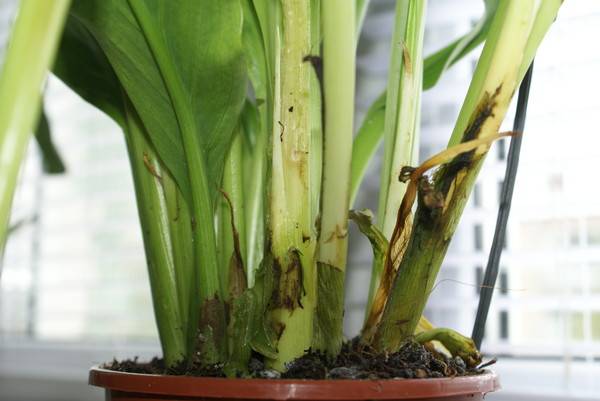

For prophylaxis, all flowers standing next to the infected calla should be treated.
In home calla lilies, the leaves turn yellow if a transplant was carried out with a complete replacement of the soil. How is it - a complete soil replacement? This is when the plant is taken out of the pot, the soil is completely shaken off from the roots and transferred to new soil.
Replace only the top layer of soil with fresh soil.
The exceptions are cases when the root system or flower bulb has suffered from waterlogging and rot. Then calla lilies are transplanted with a complete replacement of the soil, significantly reducing the volume of the pot.
If the calla was transplanted with a complete replacement of the soil and its leaves began to turn yellow, it needs special care until the moment of restoration. Watering is significantly reduced. Watering is carried out after the top layer of the soil has dried.
The higher the temperature, the more often it is sprayed. You can put a flower in a greenhouse. Calla is covered with transparent film, placed in a bright place, but not in direct sunlight. In the greenhouse, the plant is sprayed less often.
High humidity for calla lilies during the recovery period is very important, since a weakened flower can infect spider mites.
This is followed by treatment with aktara insecticide. Calla leaves are sprayed with a solution of the drug 4 g of the substance per 5 liters of water and the soil is spilled with a solution of the drug 1 g per 10 liters of water. The treatment is carried out 4 times with an interval of 7-10 days. The higher the temperature of the plant, the more often the treatment is carried out.
Plants that are located next to the affected calla are subject to processing.
A special kind of calla is grown in the garden, which is propagated by tubers, but the requirements for the cultivation of this plant remain the same. Calla is almost not damaged by pests, the plant is undemanding to the composition of the soil, if timely feeding is provided.
To avoid yellowing of the foliage, calla lilies should be planted in a light openwork partial shade, avoiding direct sunlight on the plant, preferably on the banks of a natural or artificial reservoir, in conditions of high humidity.
We offer you to read: The best tips for growing aubriets
Calla tubers are planted in open ground in early May, since return frosts are not dangerous for it. In early to mid-September, you need to dig out the tubers, rinse them and store them in perforated paper bags at a temperature of 2-5 ° C.
If it is not possible to provide such conditions, you can grow calla in a container so as not to dig up the tubers, but store them at above-zero temperatures. In this case, the plants will be better preserved. It is recommended to transplant calla lilies into fresh soil every two to three years, while seating the babies that have appeared.
Choosing calla varieties acclimated to Russian conditions, you can enjoy the flowering of this amazing plant for many years if you provide it with suitable growing conditions.
Yellowing of the leaves also occurs for natural reasons. This occurs in the fall as the plant prepares for its recovery period.During this period, calla lilies should be moved to a cool place and watering should be reduced.
Yellowing of the leaves is often caused by improper pot placement. For example, bright light, direct sunlight, and a hot battery can lead to discoloration of foliage. This also applies to over-watering calla lilies.
Improper fertilization results in soil depletion. This also applies to growing a plant in one pot for a long time. To protect the plant and prevent yellowing of the foliage, it is necessary to use appropriate fertilizers for feeding and follow the frequency of plant transplantation.
If the lower leaves begin to change color, there is no cause for concern. Thus, the calla is simply renewed.
The same applies to the yellowing of the leaves in the autumn - then the life processes of the flower freeze, and he himself begins to prepare for the dormant period, throwing off the leaves.
Yellowing of the leaves is often caused by improper pot placement. For example, bright light, direct sunlight, and a hot battery can lead to discoloration of foliage. This also applies to over-watering calla lilies.
: 5 / 5
Many growers sound the alarm when calla leaves begin to turn yellow. This may be the result of improper care (overdrying or waterlogging of the soil) or the plant retires.
Novice indoor plant lovers do not know what to do in this case. And most importantly, many do not understand the reasons why calla leaves turn yellow. So, experts explain why calla leaves turn yellow.
How to treat a flower? Detailed treatment with a photo.
Calla - flower of death
Sometimes you can hear that calla is. Where did this statement come from?
One of the reasons is that in European countries there is a custom to bring white flowers to funerals. And often they are calla lilies. Also, this plant can sometimes be found on the graves of the dead. However, other white flowers such as lilies, roses, carnations or chrysanthemums are also brought to the funeral.
Some argue that calla lilies do not look like natural flowers, but rather like wax figures. Their yellow ear resembles a candle, and their white bracts are like a burial shroud. However, such statements are purely subjective opinions, not supported by well-founded facts.
Today, almost no one remembers that calla is the flower of death.
... This myth has not been confirmed. Now kallidari for various holidays are used to create bouquets, including bridal bouquets! These are versatile flowers that can be gifted to both women and men.
Calla is a very beautiful, graceful flower that exudes a delicate pleasant aroma. It helps to increase immunity, eliminate stress and depression. Gives vigor and improves mood!
If the leaves turn yellow from disease
In order to protect the calla from pests, you need to wash it with laundry soap and then rinse it with warm water.
And yet, calla lilies are more likely to get sick. And the causes of diseases can be both infectious and domestic in nature. Much depends on whether such plants are properly cared for, how often all kinds of diseases are prevented. In the event that the plant is in a cool room or near a draft, the leaves begin to turn yellow and fall off. This plant is quite thermophilic, and with significant temperature fluctuations, it already begins to hurt. It all starts with the root system. The yellowing of the leaves already indicates that the roots of the plant are also sick. In this case, you should get the calla out of the ground, remove the diseased roots, treat the cuts with charcoal and transplant the flower into a new substrate. Immediately make sure that the pot is placed in a warmer place without drafts, otherwise everything will happen again.
Description of the plant and species
Calla is a beautifully flowering member of the Aroid family, which is considered to be the homeland of South Africa. The plant delights with its strict amazing beauty and many colors.
The houseplant calla has bare stems with large leaves that look like a heart or arrowhead. Tall peduncles at the top turn into a one-petal flower, which consists of an ear and a bracts in the form of a funnel.
Many varieties of calla lilies of various colors have been bred, including even black. Popular types:
Now you know everything about growing calla lilies in a pot and caring for a flower at home.
Natural leaf death occurs in the fall, when the calla is preparing for the recovery period. At this time, you need to reduce watering, feeding and transfer the pot with the plant to a cool, dark place until spring. Another reason for this phenomenon is improper care. Calla prefers high humidity. To make the plant feel good, you need to spray it with water at room temperature from a spray bottle more often. If the reason for the yellowing of the leaves turned out to be the neighborhood with a hot battery, then you need to rearrange the pot to another place.
Too bright light and direct sunlight can also cause yellowing and wilting of leaves. With improper watering, when the root system is waterlogged or overdried, the calla leaves also change color and wither. Watering with cold water can cause not only yellowing of the leaves, but also the death of the root system, which can lead to the death of the calla. The same will happen if the plant is systematically filled with water. To avoid this, you need to plant in a pot with drainage holes.
Another reason is the lack of nutrients in the soil, which occurs with improper fertilization and depletion of the soil during long-term cultivation of calla lilies in one container. To avoid this, it is necessary during the growing season to feed with full mineral fertilizer for flowers once every two weeks.
Care errors
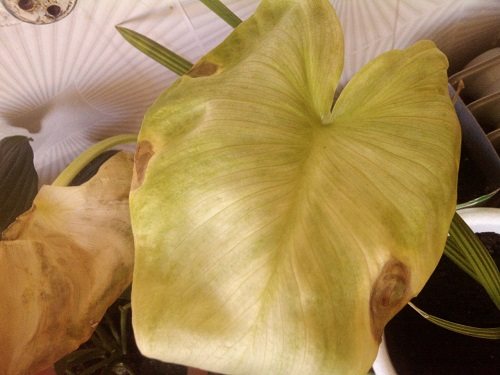

But most often, calla leaves begin to turn yellow as a result of improper care. So, the most common errors are:
- Wrong location. First of all, this applies to illumination. The southern window is not the best choice for calla lilies, since there they will be under the sun most of the day. It is better to give the flower an oriental window sill with moderate lighting. Do not forget about the temperature regime, because calla is highly sensitive to both high and low temperatures. In the summer, it is advisable not to allow it to rise above 24 degrees Celsius, in winter, a cooler regime (from 13 to 16 degrees Celsius) should be maintained.
- Unsuitable pot. Leaves may disappear if the flower is planted in a pot that is too small and there is not enough space for it.
- Violation of the watering regime. Both dry and flooded soil are unacceptable for calla lilies. In addition, if the ground is constantly wet, the roots also begin to suffer - they rot. Also, you can not water the flower with cold water.
- Malnutrition. In the case when calla is in the same soil for a long time without additional feeding, it begins to experience a lack of nutrients, which affects the development and general condition of the plant. It is important to regularly feed it with complex preparations in the spring-summer period (twice a month) and periodically change the soil.
How to avoid yellowing of the leaves when growing calla lilies in the garden
A special kind of calla is grown in the garden, which is propagated by tubers, but the requirements for the cultivation of this plant remain the same. Calla is almost not damaged by pests, the plant is undemanding to the composition of the soil, if timely feeding is provided.To avoid yellowing of the foliage, you need to plant calla lilies in a light openwork penumbra, avoiding direct sunlight on the plant, preferably on the banks of a natural or artificial reservoir, in conditions of high humidity.
Calla tubers are planted in open ground in early May, since return frosts are not dangerous for it. In early to mid-September, you need to dig up the tubers, rinse them and store them in perforated paper bags at a temperature of + 2-5 ° C. If it is not possible to provide such conditions, you can grow calla in a container so as not to dig up the tubers, but store them at above-zero temperatures. In this case, the plants will be better preserved. It is recommended to transplant calla lilies into fresh soil every two to three years, while seating the babies that have appeared.
By choosing varieties of calla lilies, acclimatized for Russian conditions, you can enjoy the flowering of this amazing plant for many years if you provide it with suitable growing conditions.
If calla lilies turn yellow leaves: what to do
Many growers are wondering if calla leaves turn yellow, what to do in this case? This plant is considered not very whimsical for growing indoors. But for this you should take proper care of him. And it is very important to notice the diseases of this flower in time and take appropriate measures. As a rule, indoor calla lilies bloom in October. The flowering period for a healthy plant ends at the end of May. But sometimes the question arises: why do not calla lilies bloom? Quite often, an already quite adult plant for many years does not even think to release buds, although outwardly it seems quite healthy. But before we begin to consider the causes of diseases from which the leaves of calla lilies disappear and buds do not appear, it is advisable to pay attention to the life cycle of this plant species. Usually these problems arise when growing white calla lilies. At the same time, people often confuse diseases with completely natural phenomena. It should be understood that, like any other indoor plant, the leaves of the calla are gradually dying off.
Calla is a whimsical plant and requires careful maintenance.
Causes of yellowing foliage
Yellowing of the leaves also occurs for natural reasons. This occurs in the fall as the plant prepares for its recovery period. During this period, calla lilies should be moved to a cool place and watering should be reduced. Since feces prefers to grow in a humid environment, at home it must be periodically sprayed from a pulivizer.
Yellowing of the leaves is often caused by improper pot placement. For example, bright light, direct sunlight, and a hot battery can lead to discoloration of foliage. This also applies to over-watering calla lilies. To avoid the appearance of such an effect, it is necessary to correctly determine the place for the normal growth of the plant, as well as follow all the tips for its care.
Improper fertilization results in soil depletion. This also applies to growing a plant in one pot for a long time. To protect the plant and prevent yellowing of the foliage, it is necessary to use appropriate fertilizers for feeding and follow the frequency of plant transplantation.
Calla lily infectious diseases, methods of dealing with them
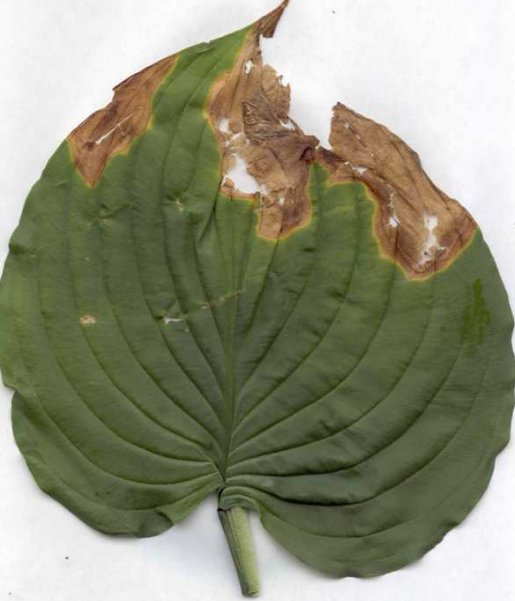

As a result of improper care or poor-quality planting material, poor soil, calla is exposed to infectious diseases. They quickly make themselves felt: the color of the plant fades, the calla leaves curl or turn yellow, dry out, the stems become brittle.
To avoid the death of the plant, it is necessary to calculate the cause of this condition and take the necessary measures in time.
Anthracnose is a fungal disease of calla lilies.
Such an ailment among these beauties is quite common.
Calla lily anthracnose has the following manifestations:
- depressed brown spots appear on the leaves;
- over time, the spots become larger in size, a red edging appears at their edges, and white mold in the center;
- leaves crack and dry;
- stems weaken;
- flowers fade and curl.
The reasons for this damage are:
- increased air temperature;
- excessive humidity in the air and soil.
Control methods:
- remove damaged leaves from plants and soil;
- reduce watering;
- move the plant away from batteries;
- treatment with fungicides ("Fundazol", "Fitosporin-M").
Important!
The fungus tends to move from leaves to the soil. Therefore, damaged fallen leaves must be removed immediately. If the disinfection measures did not help, you need to transplant the flower, while the pot should be thoroughly disinfected.
Powdery mildew develops due to the defeat of calla lilies by fungi.
With such a disease, a white bloom appears on the leaves of the plant, which very quickly increases in volume and over time covers all the leaves of the flower. Externally, the plaque looks like grains of flour that abundantly cover the surface of the calla lily. Over time, the affected parts turn black and disappear.
Control methods:
- removal of damaged leaves (if there are not very many of them);
- fungicide treatment;
- moderate watering.
Did you know?
Powdery mildew does not need an abundance of moisture, so it can develop even in dry soil. The surest method to eradicate it is three times the treatment with fungicides for indoor plants (once a week).
Calla gray rot is caused by the fungus Botrits cinera.
Unlike anthracnose, gray rot can affect all parts of the plant: leaves, stems, flowers. Diseased leaves are covered with a gray bloom, and gray-green spots appear on the flowers. Over time, the blooming part acquires a brown hue and becomes covered with a gray veil.
Causes of the disease:
- high air humidity;
- excessive watering;
- planting in contaminated soil;
- infected planting material.
Control methods:
- remove all infected leaves;
- moderate saturated watering;
- treat the plant and soil with fungicides ("Rovral", "Fundazol").
Important!
The fungus can persist in the soil for several years and be transmitted along with infected parts of the plant. Therefore, a badly damaged flower must be transplanted into new soil, and the old one thrown away. When transplanting children, treat them with fungicides.


Calla root rot is provoked by a fungus of the genus Fitovtor.
Signs of calla lily disease:
- leaves and flowers dry out;
- the plant weakens quickly;
- gray mold can be seen on the soil;
- the roots are rotting.
Causes of the disease:
- high air temperature;
- high air humidity;
- excessive watering;
- excessive fertilization;
Control methods:
- transplant into dry soil and water very sparingly at first;
- move the plant to a cool, well-ventilated area;
- review feeding practices;
- treat with fungicides ("Ridomir", "Profit-gold").
Calla lily rot is caused by bacteria of the genus Ervinia.
With a disease, the root of the plant and the base of the leaves darken, and over time they rot. The surface of the leaves becomes yellow. The plant does not dry out, but it rots.
Causes of the disease:
- high temperature and humidity;
- excessive watering;
- excessive nitrogen fertilization.
Eradication of bacteria
–
it's a very difficult matter.
It is necessary to moderate watering, treat the plant with fungicides and transplant it into healthy soil.
Why do the leaves of indoor plants curl
Brown dry tips on leaves can be caused by chemicals in tap water, flooding or overdrying a coma, pests, dry air, or over-fertilization.
1. Watering with tap water. The most common cause of plant tips to dry out is watering with tap water. This water differs from the water used by professional growers in greenhouses and gardens, as it contains chlorine and fluoride.These chemicals can rise from the roots to the leaves, causing burns. The most vulnerable plants: cordilina, chlorophytum, spathiphyllum.
Solution: fill the container with tap water and let stand for 24 hours so that the chemicals evaporate during this time.


2. Filling or overdrying an earthen coma. Brown leaf tips may also indicate that the plant is receiving too much or too little water. Excessive watering causes root rot, which translates into leaf rot. Overdrying the earthen coma leads to the drying out of the plant.
Solution: The pot with the plant must have drainage holes that prevent stagnation of water in the pot and, as a result, root rot. It is also helpful to use a soil moisture meter each time before watering to determine how much water your plant needs.


3. Pests. There are many pests that attack plants. If the plant is infested with pests, the tips of the leaves may turn brown.
Solution: The best defense against pests is prevention. Before reusing the pots, wash them thoroughly, use clean packaged soil for planting or roast the garden in the oven.
Here are some more pest control measures: Isolate new plants for a month and inspect the plant for any defects or signs of insect damage before adding new plants with others.
Wipe the plant leaves weekly with a damp soft cloth or soapy water if pests are present.
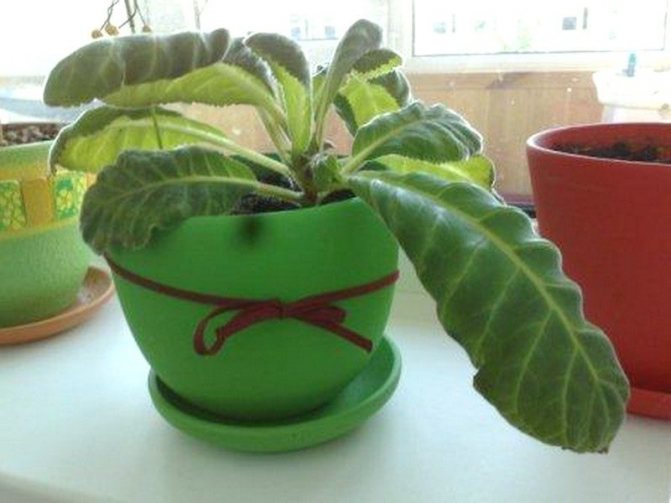

4. Dry air... Plants that naturally grow in humid regions can have problems in dry conditions. Excessive watering in this case will only worsen the situation, as it can cause rotting of the root system, which will lead to the fact that less water reaches the leaves.
Solution: In case dry air is caused by climatic conditions or heating in autumn and winter, use a humidifier. Spraying plants with a spray bottle is not effective if you don't do it every 10 minutes.
Another way out is gravel, if you put it in the pot's pan and sprinkle it with water. In this case, the bottom of the pot should not get water, so that the roots do not rot. You can use expanded clay instead of gravel. The water from the sump will evaporate, increasing the humidity in the room.
The location of the plant is also important. If you put plants together in one or more groups, it will be easier for them to fight moisture evaporation from the leaves. Also place plants as far away from heat sources as possible: fans, batteries. Also try to keep plants in the bathroom and kitchen as these rooms have the highest humidity.


5. Fertilizer. Excessive fertilization can dry out the tips. This happens, as is the case with tap water for salt burns.
Solution: If a white coating appears on the surface of the soil, remove it and replace it with new soil.
Why do calla leaves turn yellow?
We noticed that the leaves of the houseplant calla (white flower, wide green leaves) are covered with rust, turn yellow and dry. It is blooming now.
Most likely, you have white calla lilies growing. Calla flowers appear from autumn - October to May, white, in sunny weather they emit a faint pineapple aroma.
In calla lilies, old leaves gradually fall off (dying off), and new ones grow. But your plant doesn't seem to dry for this. You should take a closer look at the reason for it. If it gets sick with rust (and this is a fungal disease), then brown bumps can be seen on the leaves.
This usually happens with abundant moisture, frequent watering of the soil. It is necessary to reduce watering, spray with foundation. It is better to isolate this plant from other flowers for two to three months.
Perhaps the plant is asking for your care for other reasons.Leaves can fade and become covered with brown spots and with a lack of moisture, cooling of the roots, when it blows from the window, with drafts, sunburn, excessive doses of mineral fertilizers.
Calla does not like crowding. Its main enemy is the spider mite. The parts of the leaves damaged by the mite are dotted with micro specks and then turn yellow and dry out. It is very small and difficult to detect. It lives on the lower inconspicuous side of the leaves, braiding them with a barely noticeable cobweb. That is why the calla flower is depressed and its leaves turn yellow.
If it is found, it is worth treating the plant with actellik or every seven days with an infusion of onions or garlic, red, very hot pepper. There is also such a recipe. Insist about 100 grams of crushed citrus peels in warm and dark for 3 days, in a liter of boiled water, strain and wash the plant three or four times at intervals of 6-7 days.
How to deal with calla pests
As with any living plant, calla lilies can be attacked by pests. They suck out all the useful substances from the plant, poison it with their waste products, as a result, the plant dies. Timely measures taken to combat the misfortune will save your beauty.
Calla belongs to the Aroid or Aronnikov family. It is customary to read the homeland of calla lilies in South Africa, some species can be found in the central part of Africa, even in our latitudes you can find wild species of calla lilies that feel good in swampy areas.
A feature of calla lilies is that they can be grown both as a houseplant and a garden plant. Other names for calla lilies include the following: calla lilies and arum.
Calla is a relatively small plant with heart-shaped foliage (leaf length up to 12 centimeters, and width - 11 centimeters).
The flowers are formed on a long peduncle and is an ear that is wrapped in a funnel-shaped petal - a blanket.
Homemade calla lilies usually do not differ in aromas, but calla lilies grown in the garden exude an aroma reminiscent of a combination of pineapple and vanilla.
Flowers can be both snow-white and various shades. White calla lilies reach a height of more than 1 meter, and colored ones - up to 50 centimeters.
Calla lilies
Despite the fact that calla lilies have recently been actively involved in decorative floriculture, a fairly large variety of its species has already been bred. We will now analyze the most popular ones.
- a profusely blooming variety, it is highly decorative - the petal on the flower reaches 15 centimeters, while its outer part is greenish-yellow, and the inner part is pure yellow.
There are white spots on the heart-shaped leaves. Good illumination and regular watering are important for this calla.
The most popular varieties:
- The "Yellow Corner" has sunny flower bedspreads and rich green foliage with a yellow speck.
- "Vermeer" is distinguished by a wavy veil near the flower, which is cold white on the outside, and lilac-cherry on the inside, shimmering in a deep purple hue. The foliage is dark green in color with a white speck.
- "Black-eyed beauty" has a soft beige bedspread with a shade of lemon-yellow color, mottled foliage.
- the most common type of calla lilies. The underground part is a rhizome, unlike other calla lilies, which have a bulb.
It has dense and resilient foliage, one leaf can grow up to 45 centimeters in length. A stem with a flower can grow more than 1 meter from the ground. The flower is white in the form of a funnel, which slightly opens the yellow ear.
Popular varieties of Ethiopian calla lilies:
- Nicolai - the peduncle can grow up to half a meter in height, the foliage is dark green, in the form of arrows on long cuttings. The cover of the flower is green in color, reaching 8-12 centimeters in diameter.
- Pearls - grows up to half a meter maximum, good for growing as a pot culture
- Schone Zweibruckerin
it is distinguished by a peduncle up to 1 meter long, light heart-shaped leaves, a flower cover on the underside of a dark green shade, reaches 10-15 centimeters in diameter. - The green goddess, a majestic plant, is distinguished by a green tint not only of foliage, but also of the flowers themselves, in height it can reach 90 centimeters.
It grows up to 70 centimeters in height, is distinguished by bright pink or red flowers and a rather narrow green leaf.
The dormant period begins in the fall, at which time the plant completely sheds its foliage. It is from this species that varieties with a varied variegated color of flowers originate.
The most popular varieties:
Calla amethyst has violet flowers and a delicate scent reminiscent of the sea breeze. It can reach a height of 60 -120 centimeters, its growth directly depends on the growing conditions. This variety was very popular with royals.
Calla lily care has a number of features
Callas are not planted very deeply in the ground, they are simply covered with earth, this reduces the risk of rot.
After planting, calla lilies can sprout for a long time, this is not a cause for concern, since it emerges only when the root system is already fully formed.
Tubers should be removed from the ground as carefully as possible, as they can be very easily damaged.
Periodically, you need to change the top of the soil in a flower pot to fresh soil, while being careful and not damaging the roots of the plant.
Watering
Proper watering is a key condition for the growth and development of calla lilies at home. For these flowers, it is important to organize regular watering and constantly moisturized soil in the pot.
If the soil is dry, it will stop the growth of the plant for a long time. White feces, which naturally grow in swamps, have special requirements for watering.
It is necessary to water it when the top layer of soil in the pot dries out by 1 centimeter.
After a quarter of an hour, it is necessary to drain the water that the plant has not absorbed.
Colored calla lilies are less demanding for watering, but in any case, you need to carefully monitor the lack of water in the pan of the flower pot. It should be watered with soft settled water when the soil dries a couple of centimeters deep.
The optimum moisture level for these flowers is 70-80%, this level can be maintained by spraying 2 times a day and wiping the foliage with a damp cloth, as well as by placing cans and pallets with expanded clay or moss next to them.
After flowering is complete, watering can be reduced for all types of flowers. For colored calla lilies, after a couple of months, watering can be stopped altogether. The dormant period for the plant is from October to February.
Illumination.
Callas require high levels of scattered sunlight all year round. If there is not enough light, then flowering may not come, and only the stems of the plant will grow.
White calla lilies require lighting even during dormancy. Without sufficient light, colored calla lilies may experience color fading.
Temperature.
During the growing period for white calla lilies, it is important to maintain a temperature of 18-20 degrees, after flowering, the temperature can be gradually reduced to 10-12 degrees. The rest period is about two months.
For colored calla lilies, the content will be optimal at a temperature of 20-24 degrees. After the end of flowering, the tubers ripen for about a month without watering at a temperature of 25 -27 degrees. Then they are taken out without leaves to organize dry wintering at a temperature of 3-5 degrees, covered with sawdust.
The soil.
Acidified soils are optimal for these flowers. The substrate for planting can be prepared independently on the basis that for 2 parts of sod land you need one part of leafy earth, sand and peat.
Top dressing.
In summer, it is possible to plant plants in open ground in the garden land, in which case they will receive additional feeding.When kept at home, it is necessary to feed with complex fertilizers once every 2 weeks. During the flowering period, it is imperative to feed the flowers with urea, and you can also add an infusion of shells from eggs.
Transfer
Calla lilies must be transplanted after the end of the dormant period. If you regularly pinch the plant and change the topsoil in the pots in a timely manner, then a transplant will be required no more than once every 2 years.
Calla lilies are planted in pots in accordance with the size of the tubers, but they should not exceed 15 centimeters in diameter, and be not very deep. It is important to remember about the organization of the drainage layer in pots, it should be at least 5 centimeters.
When the dormant period ends, calla lilies are transplanted into fresh soil. With regular pinching of fresh shoots and replacing
Features of growing callas outdoors
Callas prefer sunny areas, but from the scorching sun they need to be darkened, for example, with the help of bushes or trees around, which will create the shade that plants need.
Calla lilies grow well in acidic or slightly acidic soil with good drainage. The composition of the soil can be approximately as follows - equal proportions of earth, sand, peat and leaf humus.
Planting calla lilies in open ground
Calla lilies can be planted in the garden from the beginning of May. It is advisable to pre-soak the material for planting in a solution of potassium permanganate for 30 minutes.
Then it should be well examined and the spoiled parts removed, the sections can be greased with brilliant green. To prepare the soil, you need to add a complex of mineral fertilizers at the rate of 30-40 grams per square meter and dig it up.
The tubers themselves are immersed in prepared holes to a depth of no more than 10 centimeters, keeping a distance of 30-40 centimeters between plant specimens, buried and watered. The sprouts will appear on the ground in 2-4 weeks. After planting for 2 weeks, no watering is required for the plants.
It is not difficult to take care of calla lilies in the garden, it is enough to water it in a timely manner and loosen the ground. Watering should be moderate and regular; in dry weather, watering should be increased.
After watering, the ground around the plant needs to be slightly loosened. With fertilizers applied during planting, the plant does not need additional feeding.
If the soil is not acidic enough on the site, you can soak the soil with water acidified with citric acid or vinegar.
Reproduction
Calla lilies reproduce by bulbs, dividing the bush and seeds.
Transition into a dormant period
Feces grow vigorously as long as the potted soil is moist. The active phase of development is coming to an end by the middle of autumn. Gradually, the leaves begin to turn yellow and die off.
As soon as you start observing a similar picture on your plant, watering should be reduced, and after a couple of weeks, it should be stopped altogether.
The leaves can be cut off after they are completely dry, then all the beneficial trace elements from the aerial part of the plant will go into the tubers.
The tubers can be left inside the pot, but must be moved to a cool place (balcony or veranda). The rest period should be from 3 months, if it is shortened, then perhaps the plant will not bloom this year.
Calla lily diseases
Gray mold can affect any part of the plant. It is a gray bloom. The plant can get this fungus through soil, water or air.
The chances of picking up this bend increase when the air is humid. You can help the plant by processing Vitarox or Roval.
Calla lily anthracosis appears as brown spots on the leaves, gradually the leaves dry out, crack and crumble. The affected leaves must be removed, and the flower itself must be treated with fungicides.
Root rot leads to wilting of calla leaves and peduncles. It occurs when the soil is highly moistened. In the event of this disease, it is necessary to completely stop watering and change the wet soil to a new one.Additionally, the plant can be treated with a fungicide solution.
Why doesn't calla lilies bloom?
There may be several reasons
- The flower has not been transplanted for a long time, and many bulbs have managed to form.
- The flower was replanted too often.
- Improper care.
- An excess of nitrogenous fertilizers, which contributed to the growth of foliage, depriving them of the strength for flowering. In this case, you need to make the bait with phosphorus-potassium fertilizers.
Why do the leaves turn yellow?
The causes of yellow foliage can also be different.
As you can see, caring for calla lilies is not as difficult as it might seem at the first glance at this graceful plant.
Calla can be grown at home even by a beginner in floriculture, subject to all the rules that we discussed above.
And the plant will thank you with abundant flowering, both at home and in the garden. Calla lilies will also look good as cut plants in a bouquet on your table.
Many growers sound the alarm when calla leaves begin to turn yellow. This may be the result of improper care (overdrying or waterlogging of the soil) or the plant retires. Novice indoor plant lovers do not know what to do in this case. And most importantly, many do not understand the reasons why calla leaves turn yellow. So, experts explain why calla leaves turn yellow. How to treat a flower? Detailed treatment with a photo.
Why do calla leaves turn yellow at home
Natural leaf death occurs in the fall, when the calla is preparing for the recovery period. At this time, you need to reduce watering, fertilizing and transfer the pot with the plant to a cool, dark place until spring. Another reason for this phenomenon is improper care. Calla prefers high humidity. To make the plant feel good, you need to spray it with water at room temperature from a spray bottle more often. If the reason for the yellowing of the leaves turned out to be the neighborhood with a hot battery, then you need to rearrange the pot to another place.
Too bright light and direct sunlight can also cause yellowing and wilting of leaves. With improper watering, when the root system is waterlogged or overdried, the calla leaves also change color and wither. Watering with cold water can cause not only yellowing of the leaves, but also the death of the root system, which can lead to the death of the calla. The same will happen if the plant is systematically flooded with water. To avoid this, you need to plant the calla in a pot with drainage holes.
Another reason is the lack of nutrients in the soil, which occurs with improper fertilization and depletion of the soil during long-term cultivation of calla lilies in one container. To avoid this, it is necessary to fertilize the flowers with full mineral fertilizer every two weeks during the growing season.
Why do calla leaves turn yellow at home
Natural leaf death occurs in the fall, when the calla is preparing for the recovery period. At this time, you need to reduce watering, fertilizing and transfer the pot with the plant to a cool, dark place until spring. Another reason for this phenomenon is improper care. Calla prefers high humidity. To make the plant feel good, you need to spray it with water at room temperature from a spray bottle more often. If the reason for the yellowing of the leaves turned out to be the neighborhood with a hot battery, then you need to rearrange the pot to another place.
Too bright light and direct sunlight can also cause yellowing and wilting of leaves. With improper watering, when the root system is waterlogged or overdried, the calla leaves also change color and wither. Watering with cold water can cause not only yellowing of the leaves, but also the death of the root system, which can lead to the death of the calla. The same will happen if the plant is systematically flooded with water.To avoid this, you need to plant the calla in a pot with drainage holes.
Another reason is the lack of nutrients in the soil, which occurs with improper fertilization and depletion of the soil during prolonged cultivation of calla lilies in one container. To avoid this, it is necessary during the growing season to feed with full mineral fertilizer for flowers once every two weeks.





